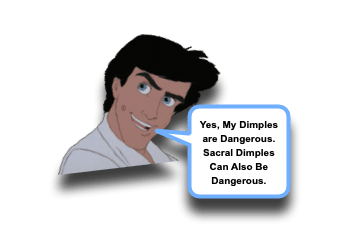Sacral Dimples and Pits

We have previously discussed the fact that children are not aliens (the newly born and neonates are almost aliens though), but that we must recognize children as a special population with unique anatomy and physiology. Sometimes those considerations also have to include the some unique abnormal anatomy. The normal anatomic development of humans doesn’t go as designed. There is a wide variety of the anatomic anomalies that may be encountered. Some anatomic anomalies are interesting (ex, Natal Teeth), some are common (ex, Lacrimal Duct obstruction), and some can lead to complications (ex, Branchial Cleft Cysts and Thyroglossal Duct Cysts). Let us review another anatomic anomaly that may be encountered in the ED while assessing children – Sacral Dimples and Pits:
Sacral Dimples and Pits: Background
- Sacral dimples or pits are common. [Wu, 2020]
- ~2-4% of all newborns have a sacral dimple. [Wilson, 2016]
- Should be overlying the sacral bone or towards the gluteal cleft. [Wu, 2020]
- Have been associated with Closed Neural Tube Defects. [Zywicke, 2011]
- Neural Tube Defects: [Zywicke, 2011]
- Open vs Closed
- Open – kinda obvious (cuz they are open!)
- Closed – have skin covering over the central nervous system defects.
- Closed are often termed “spinal bifida“
- This is not a precise term.
- Spina Bifida occulta may be normal variant.
- Occult Spinal Dysraphism (OSD) –
- Include a wide spectrum of skin-covered neural tube defects.
- Commonly have neurologic impairment!
- Closed Neural Tube Defects include:
- Split Cord Malformations
- Spinal cord is divided into two parts by bone/cartilage
- Dermal Sinus Tract
- Epithelial lined sinus tract that connects dermal structures to neural structures
- Tethered Spinal Cord
- Abnormal attachment of lower end of spinal cord to surrounding tissues
- Intraspinal Lipoma
- Tethered spinal cord attached to a benign fatty tumor in the back
- Split Cord Malformations
- Open vs Closed
- Closed neural tube defects and occult spinal dysraphisms may not be obvious at birth: [Wu, 2020; Zywicke, 2011]
- Covered by skin
- Neurologic impairment may not be notable until developmental milestones are missed
- Closed neural tube defects may cause lasting and even progressive morbidity. [Zywicke, 2011]
- Paresis
- Spasticity
- Sensory disturbances
- Contractures
- Orthopedic deformities
- Bowel and/or Bladder dysfunction
- Early detection is believed to improve morbidity and outcomes. [Wu, 2020; Zywicke, 2011]
Sacral Dimples and Pits: When to Worry
- Sacral dimples and pits are more common than Closed Neural Tube Defects. [Wu, 2020; Wilson, 2016; McGovern, 2013; Zywicke, 2011]
- Not all dimples are associated with underlying neural tube defect!
- Solitary, midline pits located entirely within the gluteal cleft rarely have clinical significance.
- Isolated sacral dimples are poor marker of occult dysraphism.
- Association with other findings is important to consider.
- Sacral dimples / pits associated with the following should raise your concern: [Wu, 2020; Zywicke, 2011]
- Multiple dimples
- Not Midline
- Dimple > 5 mm in diameter
- Dimple > 2.5 cm above anal verge
- Duplicated / Deviated gluteal cleft
- Caudal appendage
- Other cutaneous findings:
- Capillary hemangioma / Vascular Nevus
- Hypertrichosis (hairy patch)
- Subcutaneous mass (ex, lipoma)
- Sacral dimples / pits associated with other orthopedic or neurologic abnormalities also warrant concern: [Wu, 2020; Zywicke, 2011]
- Clubfeet
- Arthrogryposis
- Hip dislocation
- Scoliosis or kyphosis
Sacral Dimples and Pits: Evaluation
- The majority of anatomic anomalies will have been detected in the newborn nursery in by the primary care physician… but…
- Not everyone has access to excellent primary care, …
- Symptoms of closed neural tube defects can be insidious, …
- A new neurologic complaint (ex, abdominal “mass” which turns out to be distended bladder) may lead to ED evaluation and your vigilance and thoroughness notes the sacral dimple.
- If asymptomatic, and without any concerning associated findings, likely requires no evaluation – just typical follow-up.
- If decision is made to evaluate, images are needed.
- Ultrasound [Wu, 2020; McGovern, 2013; Zywicke, 2011]
- U/S of the lumbosacral area is an option up to ~ 3 months of age (before vertebral arches ossify)
- Can assess:
- Level of conus medullaris
- Diameter of film terminale
- Movement of the spinal cord and roots
- If U/S is abnormal, will need MRI.
- MRI [Wu, 2020; Zywicke, 2011]
- MRI is more reliable on determining diagnosis.
- Some institutions / specialists favor MRI over U/S for at risk patients.
- May be best to consult your neurosurgical friends to account for the variability.
- Ultrasound [Wu, 2020; McGovern, 2013; Zywicke, 2011]
Moral of the Morsel
- Not all oddities are problematic. Sacral dimples and pits are much more commonly found than are closed neural tube defects.
- Look for red flags. Actively look for concerning findings.
- Use super vision! Ultrasound can visualize the underlying structures in children less than 3 months of age.
- Call a friend. Consultation with neurosurgery will help streamline evaluation and follow-up.


Informative practical tips.
Regards
Hello,
This may be a typo but a sacral dimple that is 2.5 cm above anal verge should raise your concern (instead of 2.5 mm). I can send a reference if you need.
Thank you for your content. It is really helpful and practical.
thanks for catching the typo!
-sean